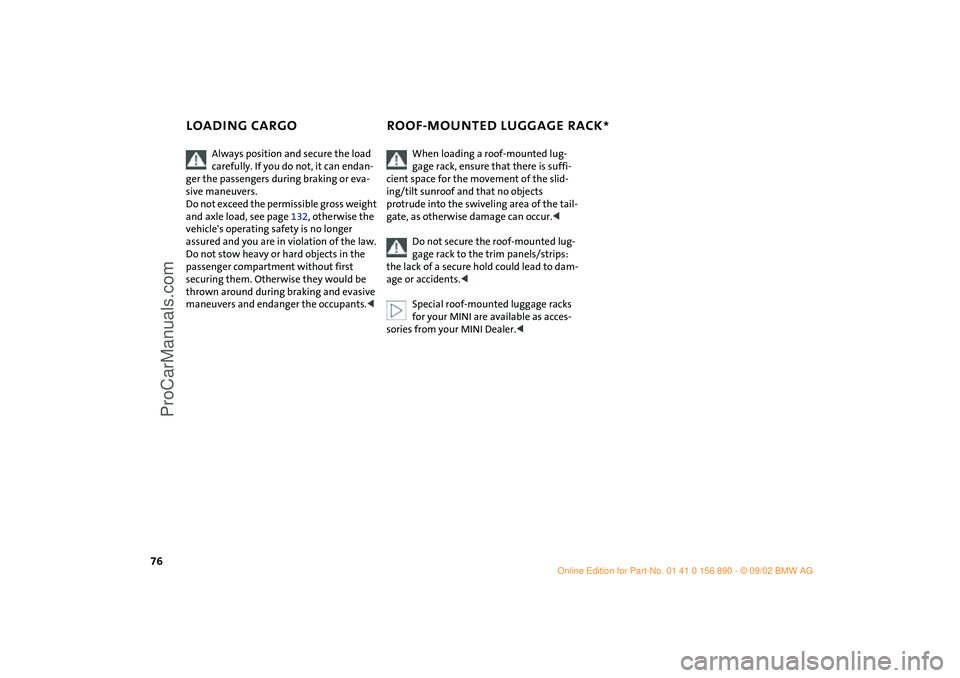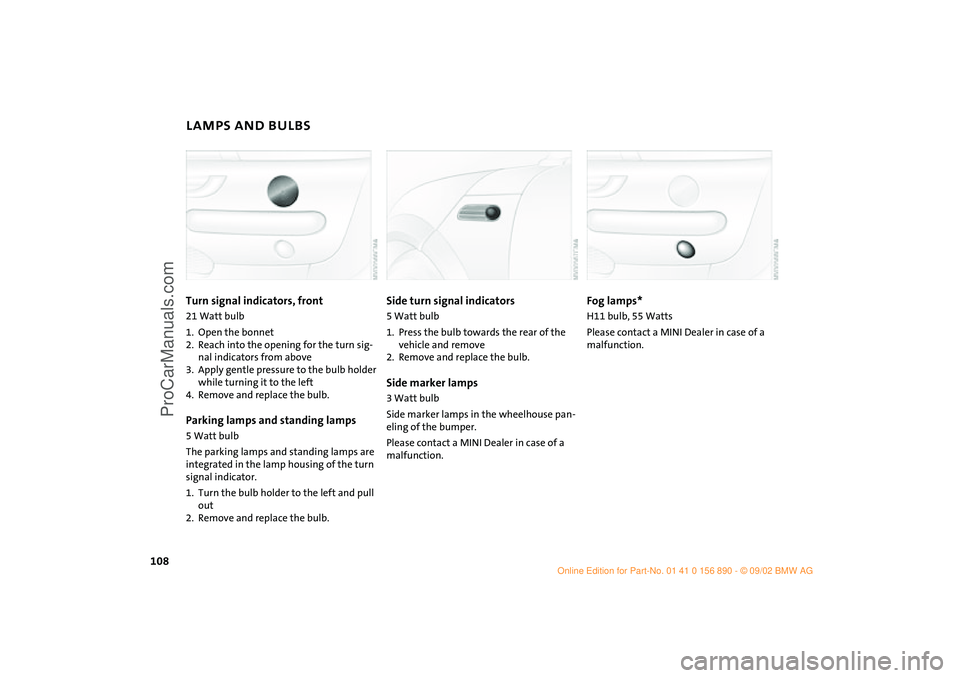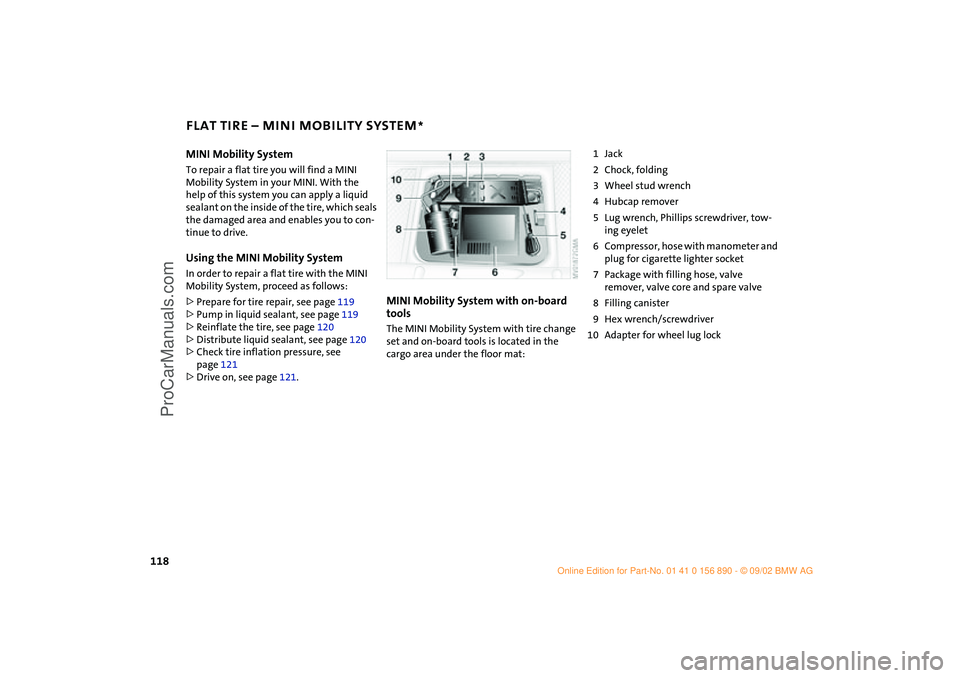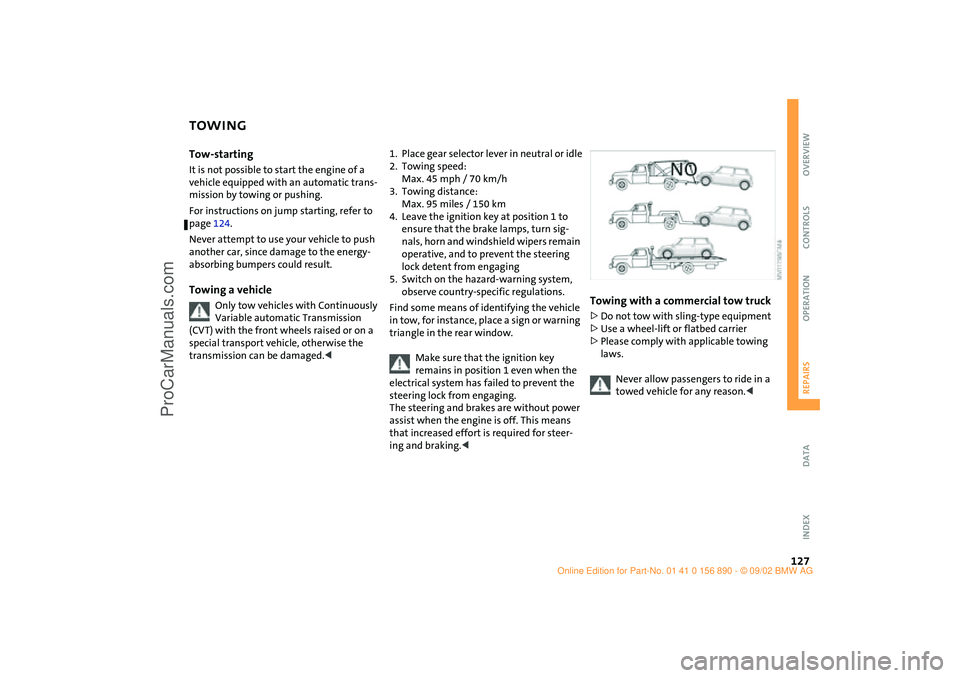tow MINI COOPER 2003 User Guide
[x] Cancel search | Manufacturer: MINI, Model Year: 2003, Model line: COOPER, Model: MINI COOPER 2003Pages: 148, PDF Size: 3.17 MB
Page 78 of 148

76
LOADING CARGO ROOF-MOUNTED LUGGAGE RACK
*
Always position and secure the load
carefully. If you do not, it can endan-
ger the passengers during braking or eva-
sive maneuvers.
Do not exceed the permissible gross weight
and axle load, see page 132, otherwise the
vehicle's operating safety is no longer
assured and you are in violation of the law.
Do not stow heavy or hard objects in the
passenger compartment without first
securing them. Otherwise they would be
thrown around during braking and evasive
maneuvers and endanger the occupants.<
When loading a roof-mounted lug-
gage rack, ensure that there is suffi-
cient space for the movement of the slid-
ing/tilt sunroof and that no objects
protrude into the swiveling area of the tail-
gate, as otherwise damage can occur.<
Do not secure the roof-mounted lug-
gage rack to the trim panels/strips:
the lack of a secure hold could lead to dam-
age or accidents.<
Special roof-mounted luggage racks
for your MINI are available as acces-
sories from your MINI Dealer.<
ba.book Seite 76 Montag, 5. August 2002 8:09 20
ProCarManuals.com
Page 89 of 148

87
OVERVIEW REPAIRSOPERATIONCONTROLS DATA INDEX
TIRE CONDITION TIRE REPLACEMENTTire tread/tire damageInspect your tires frequently for tread wear,
signs of damage and for foreign objects
lodged in the tread. Check the tread depth.
The tread depth should not fall below1/8 in / 3 mm.
Below
1/8 in / 3 mm tread pattern depth,
there is an increased risk of hydroplaning,
even at relatively moderate speeds and
with only small amounts of water on the
road.
Wear indicators in the tread-groove base,
see arrow, are spread around the circum-
ference of the tire and are marked on the
side wall of the tire with TWI – Tread Wear
Indicator. The indicators in the tread indi-
cate at 1/16 in / 1.6 mm tread depth that
the legally permitted wear limit has been
reached.
Never continue to drive with a flat,
pressureless tire, except with Run Flat
tires. A pressureless, flat tire greatly
impairs steering and braking response, and
can lead to complete loss of control over
the vehicle. Avoid overloading the vehicle
so that the permitted load on the tires is
not exceeded. Overloading can lead to
overheating and increases the rate at
which damage develops inside the tires.
The ultimate result can assume the form of
a sudden air loss.
Unusual vibrations while driving, caused
for example by driving over a curb or simi-
lar, can indicate wheel or tire damage or
other damage to the vehicle. This is also
true for irregularities in the vehicle's han-
dling characteristics, such as a pronounced
tendency to pull to the left or right. Should
this occur, respond by immediately reduc-
ing your speed. Proceed carefully to the
nearest MINI Dealer or professional tire
center, or have the vehicle towed there to
have its wheels and/or tires inspected or
controlled. Tire damage – up to and includ-
ing blowouts – can endanger the lives of
both the vehicle occupants and other road
users.<
To maintain good handling and vehicle
response, use only tires of a single tread
configuration from a single manufacturer.
The manufacturer of your MINI tests and
approves wheel and tire combinations.
Do not use retreaded tires, since driv-
ing safety may be impaired. This is
due to the possible variations in casing
structures and, in some cases, to their
extreme age, which can lead to a decrease
in their durability.
Temperature A B C
All passenger car tires must conform
to Federal Safety Requirements in
addition to these grades.<
ba.book Seite 87 Montag, 5. August 2002 8:09 20
ProCarManuals.com
Page 96 of 148

94
WASHER FLUID ENGINE OILHeadlamp* and windshield washer
systemsThe capacity of the headlamp washer sys-
tem is approx. 2.6 quarts / 2.5 liters, that of
the windshield washer system approx.
2.1 quarts / 2.0 liters.
Fill with water and – if required – with anti-
freeze, according to manufacturer's recom-
mendations.
We recommend that you mix the
washer fluid before adding it to the
reservoir.<
Antifreeze agent for the washer sys-
tems is flammable. Always keep it
well away from sparks and open flames,
and store it in tightly closed containers well
out of the reach of children. Always observe
the instructions for use provided on the
container.<
The illustration shows as an example the
dipstick of the MINI COOPER.Measuring the oil level 1. Park the vehicle on a level surface
2. Switch the engine off after it has
reached normal operating temperature
3. Pull the dipstick out after approx.
5 minutes and wipe it off with a lint-free
cloth, paper towel, or similar material
4. Carefully push the dipstick all the way
into the guide tube and pull it out again.
The oil level must be between the two
marks on the dipstick.
As with fuel economy, oil consumption is
directly influenced by your driving style and
vehicle operating conditions.
ba.book Seite 94 Montag, 5. August 2002 8:09 20
ProCarManuals.com
Page 108 of 148

106
ON-BOARD TOOL KIT WINDSHIELD WIPER BLADESStorage locationThe picture shows as an example tire
change set with on-board tools for vehicles
with the space-saver spare tire.
Depending on the level of equipment
options, your MINI is fitted with a special
on-board tool kit stored at the following
locations:
Tire change set for space-saver spare tire:
In the cargo area under the floor mat.
MINI Mobility System with tire change set
and on-board tools:
In the cargo area under the floor mat.
Tire change set and on-board tools for Run
Flat tires:
Tire change set: in cargo area in a separate
bag – On-board tools: on the left behind
the side panels next to the emergency kit,
see page 124.
Windshield wiper1. Rotate the wiper arm completely out
from the windshield
2. Set the wiper blade at an angle
3. Press the securing spring, see arrow
4. Unhook the wiper blade towards the
windshield
5. Pull the wiper blade past the wiper arm
toward the top
6. Insert the new wiper blade
7. Press into position until you hear it
engage.
Rear window wiper1. Rotate the wiper arm completely out
from the windshield
2. Turn the wiper blade as far as it will go
to the rear, see arrow
3. Press the wiper blade against the limit
and thus out of the mounting
4. Press the new wiper blade into the
mounting.
ba.book Seite 106 Montag, 5. August 2002 8:09 20
ProCarManuals.com
Page 110 of 148

108
LAMPS AND BULBSTurn signal indicators, front 21 Watt bulb
1. Open the bonnet
2. Reach into the opening for the turn sig-
nal indicators from above
3. Apply gentle pressure to the bulb holder
while turning it to the left
4. Remove and replace the bulb.Parking lamps and standing lamps 5 Watt bulb
The parking lamps and standing lamps are
integrated in the lamp housing of the turn
signal indicator.
1. Turn the bulb holder to the left and pull
out
2. Remove and replace the bulb.
Side turn signal indicators5 Watt bulb
1. Press the bulb towards the rear of the
vehicle and remove
2. Remove and replace the bulb.Side marker lamps3 Watt bulb
Side marker lamps in the wheelhouse pan-
eling of the bumper.
Please contact a MINI Dealer in case of a
malfunction.
Fog lamps* H11 bulb, 55 Watts
Please contact a MINI Dealer in case of a
malfunction.
ba.book Seite 108 Montag, 5. August 2002 8:09 20
ProCarManuals.com
Page 114 of 148

112
REPAIRING A FLAT TIRE CHANGING TIRES – MINI WITH SPACE-SAVER SPARE TIRE
*
Safety measures in the event of a flat
tire:
Stop the vehicle as far as possible from
passing traffic. Switch on the hazard warn-
ing flashers.
Turn the steering wheel to the straight-
ahead wheel position and engage the
steering lock. Engage the parking brake and
shift into 1st or reverse gear – selector lever
in P.
All passengers should be outside the vehi-
cle and well away from your immediate
working area – behind a guardrail, for
instance.
If a warning triangle or portable hazard
warning lamp is available, set it up on the
roadside at an appropriate distance from
the rear of the vehicle. Comply with all
safety guidelines and regulations.<
In the event of a flat tire, different proce-
dures should be followed depending on the
equipment included in your MINI:
>Vehicles with space-saver spare tire, see
the next chapter
>Vehicles with Run Flat tires, see page 116
>Vehicles with MINI Mobility System, see
page 118.
Additional safety measures in the
event of a wheel change:
Change the wheel only on a level, firm sur-
face which is not slippery.
Avoid jacking the vehicle on a soft or slip-
pery support surface – on snow, ice, loose
gravel, etc. – as either the vehicle or the
jack could slip sideways.
Do not use a wooden block or similar object
as a support base for the jack, as this would
prevent it from extending to its full support
height and reduce its load-carrying capac-
ity.
Do not lie under the vehicle or start the
engine when the vehicle is supported by
the jack – risk of fatal injury.<
To change a space-saver tire, proceed as
follows:
>Remove the space-saver spare tire, see
page 113
>Prepare the vehicle, see page 114
>Jack up the vehicle, see page 114
>Fit the space-saver spare tire, see
page 115
>Tighten the lug bolts, see page 115
>Drive with space-saver spare tire, see
page 115.
Tire change setOn vehicles with a space-saver spare tire,
the tire change set is stored in the cargo
area under the floor mat.
1Chock, folding
2Hubcap remover
3Wheel stud wrench
4Jack
5Spanner
6Tow fitting
7Lifting handle
ba.book Seite 112 Montag, 5. August 2002 8:09 20
ProCarManuals.com
Page 116 of 148

114
CHANGING TIRES – MINI WITH SPACE-SAVER SPARE TIRE
*
9. Pull out the space-saver spare tire
towards the rear underneath the vehi-
cle
10. Position the space-saver spare tire with
the valve facing upwards
11. Unscrew the valve extension from the
valve of the space-saver spare tire
12. Unscrew the dust cap from the exten-
sion and attach to the space-saver
spare tire.
Preparing the vehicle
Read and comply with the safety pre-
cautions provided on page 112.<
1. Secure the vehicle to prevent it from roll-
ing:
Place the folding chock behind the front
wheel on the other side of the vehicle;
on downward inclines, place it in front of
this wheel.
If the wheel is changed on a surface with
a more severe slope, take additional pre-
cautions to secure the vehicle from roll-
ing
2. Loosen the lug bolts by a half turn.
Jacking up the vehicle1. Place the jack at the jacking point closest
to the wheel.
The jack base must be perpendicular to
the surface beneath the jacking point
ba.book Seite 114 Montag, 5. August 2002 8:09 20
ProCarManuals.com
Page 120 of 148

118
FLAT TIRE – MINI MOBILITY SYSTEM
*
MINI Mobility System
To repair a flat tire you will find a MINI
Mobility System in your MINI. With the
help of this system you can apply a liquid
sealant on the inside of the tire, which seals
the damaged area and enables you to con-
tinue to drive. Using the MINI Mobility SystemIn order to repair a flat tire with the MINI
Mobility System, proceed as follows:
>Prepare for tire repair, see page 119
>Pump in liquid sealant, see page 119
>Reinflate the tire, see page 120
>Distribute liquid sealant, see page 120
>Check tire inflation pressure, see
page 121
>Drive on, see page 121.
MINI Mobility System with on-board
toolsThe MINI Mobility System with tire change
set and on-board tools is located in the
cargo area under the floor mat:
1Jack
2Chock, folding
3Wheel stud wrench
4Hubcap remover
5Lug wrench, Phillips screwdriver, tow-
ing eyelet
6Compressor, hose with manometer and
plug for cigarette lighter socket
7Package with filling hose, valve
remover, valve core and spare valve
8Filling canister
9Hex wrench/screwdriver
10 Adapter for wheel lug lock
ba.book Seite 118 Montag, 5. August 2002 8:09 20
ProCarManuals.com
Page 128 of 148

126
TOWINGFor towing, use either a tow bar or a nylon
rope or nylon belts that prevent sudden
jerking movements.Tow fittingThe screw-in tow fitting is stored in the
onboard tool kit; be sure that it remains in
the vehicle at all times. This fitting is
designed for installation in the tow sockets
located at the front and rear of the vehicle.
It is intended for towing on paved road sur-
faces only.
Access to tow socketsUse a suitable object – e.g. credit card,
screwdriver – to press out the covers from
the recess.
Firmly screw in the towing eyelet
until it stops. If this is not done, the
threads could be damaged.
Never attach tie-down hooks, chains,
straps, or tow hooks to tie rods, control
arms, or any other part of the vehicle sus-
pension, as severe damage to these compo-
nents will occur, possibly leading to acci-
dents.<
Avoid staggered towing and be care-
ful that the towing rope is in tight
tension before starting to drive the vehicle
that is towing.<
Tow barsIf the tow fittings of the two vehicles are
not directly opposite one another, please
note:
>Clearance and maneuvering capability
will be strictly limited in corners
>The inclination of the tow bar generates
lateral force – critical above all if the road
surface is slippery.
Do not tow a vehicle that is heavier
than the towing vehicle, otherwise it
will no longer be possible to control the
vehicle's response.<
ba.book Seite 126 Montag, 5. August 2002 8:09 20
ProCarManuals.com
Page 129 of 148

127
OVERVIEW REPAIRSOPERATION CONTROLS DATA INDEX
TOWINGTow-startingIt is not possible to start the engine of a
vehicle equipped with an automatic trans-
mission by towing or pushing.
For instructions on jump starting, refer to
page 124.
Never attempt to use your vehicle to push
another car, since damage to the energy-
absorbing bumpers could result.Towing a vehicle
Only tow vehicles with Continuously
Variable automatic Transmission
(CVT) with the front wheels raised or on a
special transport vehicle, otherwise the
transmission can be damaged.<
1. Place gear selector lever in neutral or idle
2. Towing speed:
Max. 45 mph / 70 km/h
3. Towing distance:
Max. 95 miles / 150 km
4. Leave the ignition key at position 1 to
ensure that the brake lamps, turn sig-
nals, horn and windshield wipers remain
operative, and to prevent the steering
lock detent from engaging
5. Switch on the hazard-warning system,
observe country-specific regulations.
Find some means of identifying the vehicle
in tow, for instance, place a sign or warning
triangle in the rear window.
Make sure that the ignition key
remains in position 1 even when the
electrical system has failed to prevent the
steering lock from engaging.
The steering and brakes are without power
assist when the engine is off. This means
that increased effort is required for steer-
ing and braking.<
Towing with a commercial tow truck >Do not tow with sling-type equipment
>Use a wheel-lift or flatbed carrier
>Please comply with applicable towing
laws.
Never allow passengers to ride in a
towed vehicle for any reason.<
ba.book Seite 127 Montag, 5. August 2002 8:09 20
ProCarManuals.com